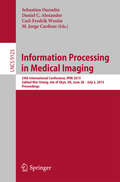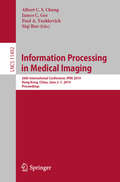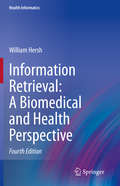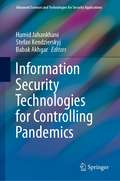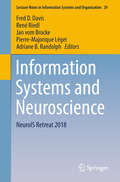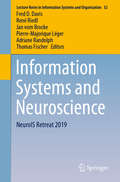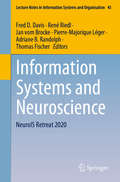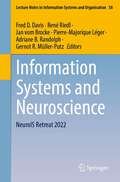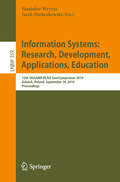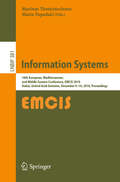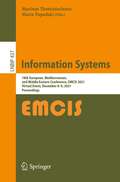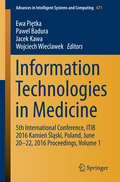- Table View
- List View
Information Privacy in the Evolving Healthcare Environment (HIMSS Book Series)
by Linda KoontzAdvances in health information technology (health IT) have the potential to improve the quality of healthcare, to increase the availability of health information for treatment, and to implement safeguards that cannot be applied easily or cost-effectively to paper-based health records. However, the digitization of health information is also raising new privacy risks and concerns. Sensitive health information in digital form is more easily aggregated, used, and shared. In addition, the rising cost of healthcare and the search for efficiency may create incentives to use the information in new ways. Research has consistently shown that while the public sees the potential value of health information exchange and technological advancements, it remains gravely concerned about the privacy of their sensitive health information. As a result, it is becoming increasingly clear that ensuring public trust will be critical to the successful implementation of nationwide health information exchange. The purpose of this second edition is two-fold: 1) to educate readers about privacy concepts and 2) highlight key privacy issues facing the nation and the healthcare community as it moves towards electronic health records and health information exchange. The first three chapters are descriptive in nature, defining privacy and distinguishing it from security, defining the complex legal landscape for health information privacy, and setting the stage for the following chapters by describing the current landscape of the evolving healthcare environment. The following chapters discuss specific privacy issues and challenges in detail. The book concludes with a chapter providing a view to the future of healthcare and the association privacy implications. This is an updated version of one of HIMSS’ best-selling books on information privacy.
Information Processing in Medical Imaging
by Daniel C. Alexander Carl-Fredrik Westin Sebastien Ourselin M. Jorge CardosoThis book constitutes the proceedings of the 24th International Conference on Information Processing in Medical Imaging, IPMI 2015, held at the Sabhal Mor Ostaig College on the Isle of Skye, Scotland, UK, in June/July 2015. The 22 full papers and 41 poster papers presented in this volume were carefully reviewed and selected from 195 submissions. They were organized in topical sections named: probabilistic graphical models; MRI reconstruction; clustering; statistical methods; longitudinal analysis; microstructure imaging; shape analysis; multi-atlas fusion; fast image registration; deformation models; and the poster session.
Information Processing in Medical Imaging: 25th International Conference, IPMI 2017, Boone, NC, USA, June 25-30, 2017, Proceedings (Lecture Notes in Computer Science #10265)
by Marc Niethammer, Martin Styner, Stephen Aylward, Hongtu Zhu, Ipek Oguz, Pew-Thian Yap and Dinggang ShenThis book constitutes the proceedings of the 25th International Conference on Information Processing in Medical Imaging, IPMI 2017, held at the Appalachian State University, Boon, NC, USA, in June 2017. The 53 full papers presented in this volume were carefully reviewed and selected from 147 submissions. They were organized in topical sections named: analysis on manifolds; shape analysis; disease diagnosis/progression; brain networks an connectivity; diffusion imaging; quantitative imaging; imaging genomics; image registration; segmentation; general image analysis.
Information Processing in Medical Imaging: 26th International Conference, IPMI 2019, Hong Kong, China, June 2–7, 2019, Proceedings (Lecture Notes in Computer Science #11492)
by James C. Gee Paul A. Yushkevich Siqi Bao Albert C. ChungThis book constitutes the proceedings of the 26th International Conference on Information Processing in Medical Imaging, IPMI 2019, held at the Hong Kong University of Science and Technology, Hong Kong, China, in June 2019. The 69 full papers presented in this volume were carefully reviewed and selected from 229 submissions. They were organized in topical sections on deep learning and segmentation; classification and inference; reconstruction; disease modeling; shape, registration; learning motion; functional imaging; and white matter imaging. The book also includes a number of post papers.
Information Retrieval: A Health And Biomedical Perspective (Health Informatics)
by William HershThis extensively revised 4th edition comprehensively covers information retrieval from a biomedical and health perspective, providing an understanding of the theory, implementation, and evaluation of information retrieval systems in the biomedical and health domain. It features revised chapters covering the theory, practical applications, evaluation and research directions of biomedical and health information retrieval systems. Emphasis is placed on defining where current applications and research systems are heading in a range of areas, including their use by clinicians, consumers, researchers, and others. Information Retrieval: A Biomedical and Health Perspective provides a practically applicable guide to range of techniques for information retrieval and is ideal for use by both the trainee and experienced biomedical informatician seeking an up-to-date resource on the topic.
Information Retrieval: A Health and Biomedical Perspective
by William HershThe third edition of this book will reach across disciplines and address the needs of not only those who study, evaluate, and purchase health information, but also computer and library/information scientists, information technology developers building databases, search engines, Web sites, and other systems for universities and hospitals who enthusiastically read the first two editions. The book is divided into three sections: Basic Concepts, State of the Art and Research Directories. Major changes to the this edition will include a new chapter in the State of the Art section on Digital Libraries and a new focus on areas related to information retrieval systems covering such topics as electronic publishing of journals and other scientific materials, emerging standards, open access publishing issues, digital preservation, that summarize and categorize documents to handle the vast amount of information that is now available. Web updates, which include keeping track of new systems, technologies, studies, are folded into the third edition to show the advancement from 1996 to present time.
Information Security Technologies for Controlling Pandemics (Advanced Sciences and Technologies for Security Applications)
by Babak Akhgar Hamid Jahankhani Stefan KendzierskyjThe year 2020 and the COVID-19 pandemic marked a huge change globally, both in working and home environments. They posed major challenges for organisations around the world, which were forced to use technological tools to help employees work remotely, while in self-isolation and/or total lockdown. Though the positive outcomes of using these technologies are clear, doing so also comes with its fair share of potential issues, including risks regarding data and its use, such as privacy, transparency, exploitation and ownership. COVID-19 also led to a certain amount of paranoia, and the widespread uncertainty and fear of change represented a golden opportunity for threat actors. This book discusses and explains innovative technologies such as blockchain and methods to defend from Advanced Persistent Threats (APTs), some of the key legal and ethical data challenges to data privacy and security presented by the COVID-19 pandemic, and their potential consequences. It then turns to improved decision making in cyber security, also known as cyber situational awareness, by analysing security events and comparing data mining techniques, specifically classification techniques, when applied to cyber security data. In addition, the book illustrates the importance of cyber security, particularly information integrity and surveillance, in dealing with an on-going, infectious crisis. Aspects addressed range from the spread of misinformation, which can lead people to actively work against measures designed to ensure public safety and minimise the spread of the virus, to concerns over the approaches taken to monitor, track, trace and isolate infectious cases through the use of technology. In closing, the book considers the legal, social and ethical cyber and information security implications of the pandemic and responses to it from the perspectives of confidentiality, integrity and availability.
Information Security in Healthcare: Managing Risk (HIMSS Book Series)
by Terrell W. HerzigInformation Security in Healthcare is an essential guide for implementing a comprehensive information security management program in the modern healthcare environment. Combining the experience and insights of top healthcare IT managers and information security professionals, this book offers detailed coverage of myriad
Information Sharing and Collaboration: Workshop Summary
by Deepali M. PatelAfter the September 11, 2001, terrorist attacks and subsequent anthrax mailings, the U. S. government prioritized a biosurveillance strategy aimed at detecting, monitoring, and characterizing national security health threats in human and animal populations, food, water, agriculture, and the environment. However, gaps and challenges in biosurveillance efforts and integration of biosurveillance activities remain. September 8-9, 2011, the IOM held a workshop to explore the information-sharing and collaboration processes needed for the nation's integrated biosurveillance strategy.
Information Skills for Nursing Students (Transforming Nursing Practice Series)
by Kay HutchfieldIt is essential for nursing students to access current and reliable information to succeed in academic assignments and nursing practice, yet there are increasingly diverse information sources available, which can raise questions about the authenticity and reliability of information provided. This book presents a practical and clear guide to mastering information skills. It shows the reader how to effectively plan and implement a search for information and make judgements on the quality of the sources found. It also gives strategies for storage and retrieval of information, helping nurses to maximise the time they have available for keeping up to date.
Information Systems and Neuroscience: Gmunden Retreat On Neurois 2016 (Lecture Notes in Information Systems and Organisation #16)
by Jan Vom Brocke René Riedl Pierre-Majorique Léger Fred D. Davis Adriane B. RandolphThis book presents the proceedings of the NeuroIS Retreat 2018, June 19-21, Vienna, Austria, reporting on topics at the intersection of Information Systems (IS) research, neurophysiology and the brain sciences. Readers will discover the latest findings from top scholars in the field of NeuroIS, which offer detailed insights on the neurobiology underlying IS behavior, essential methods and tools and their applications for IS, as well as the application of neuroscience and neurophysiological theories to advance IS theory.
Information Systems and Neuroscience: NeuroIS Retreat 2019 (Lecture Notes in Information Systems and Organisation #32)
by Thomas Fischer Jan Vom Brocke René Riedl Pierre-Majorique Léger Fred D. Davis Adriane RandolphThis book presents the proceedings of the NeuroIS Retreat 2019, held on June 4–6 in Vienna, Austria, reporting on topics at the intersection of information systems (IS) research, neurophysiology and the brain sciences. Featuring the latest findings from top scholars in the field, it offers detailed insights into the neurobiology underlying IS behavior, essential methods and tools and their applications for IS, as well as applying neuroscience and neurophysiological to advance IS theory.
Information Systems and Neuroscience: NeuroIS Retreat 2020 (Lecture Notes in Information Systems and Organisation #43)
by Thomas Fischer Jan Vom Brocke René Riedl Pierre-Majorique Léger Fred D. Davis Adriane B. RandolphThis book presents the proceedings of the virtual conference NeuroIS Retreat 2020, June 2–4, hosted in Austria, reporting on topics at the intersection of information systems (IS) research, neurophysiology and the brain sciences. Readers will discover the latest findings from top scholars in the field of NeuroIS, which offer detailed insights on the neurobiology underlying IS behavior, essential methods and tools and their applications for IS, as well as the application of neuroscience and neurophysiological theories to advance IS theory.
Information Systems and Neuroscience: NeuroIS Retreat 2021 (Lecture Notes in Information Systems and Organisation #52)
by Jan Vom Brocke René Riedl Pierre-Majorique Léger Fred D. Davis Adriane B. Randolph Gernot Müller-PutzThis book presents the proceedings of the NeuroIS Retreat 2021, June 1-3, virtual conference, reporting on topics at the intersection of information systems (IS) research, neurophysiology and the brain sciences. Readers will discover the latest findings from top scholars in the field of NeuroIS, which offer detailed insights on the neurobiology underlying IS behavior, essential methods and tools and their applications for IS, as well as the application of neuroscience and neurophysiological theories to advance IS theory.
Information Systems and Neuroscience: NeuroIS Retreat 2022 (Lecture Notes in Information Systems and Organisation #58)
by Jan Vom Brocke René Riedl Pierre-Majorique Léger Fred D. Davis Adriane B. Randolph Gernot R. Müller-PutzThis book presents the proceedings of the NeuroIS Retreat 2022, June 14-16, Vienna, Austria, reporting on topics at the intersection of information systems (IS) research, neurophysiology and the brain sciences. Readers will discover the latest findings from top scholars in the field of NeuroIS, which offer detailed insights on the neurobiology underlying IS behavior, essential methods and tools and their applications for IS, as well as the application of neuroscience and neurophysiological theories to advance IS theory.
Information Systems for Healthcare Management (Eighth Edition)
by Donna J. Slovensky Gerald L. Glandon Detlev H. SmaltzThis bestseller provides readers with the comprehensive knowledge necessary to understand healthcare information technology (HIT) and to hone their skills in HIT management. The book explores the areas where leaders must exhibit basic awareness or competency, including hardware, software, and communication systems; operational, management, and clinical applications; and selection, implementation, and valuation. <p><p> Each chapter has been updated to reflect current trends and challenges in the field as well as the implications of the 2010 healthcare reform law and other relevant federal mandates. Each chapter also features learning objectives, web resources, and discussion questions. This revised edition includes a glossary that clarifies technical terms as well as a list of abbreviations for important terms. Links to Internet sources are provided to supplement the information on the major topics covered in each chapter.
Information Systems: 12th SIGSAND/PLAIS EuroSymposium 2019, Gdansk, Poland, September 19, 2019, Proceedings (Lecture Notes in Business Information Processing #359)
by Stanisław Wrycza Jacek MaślankowskiThis book constitutes the refereed proceedings of the 12th SIGSAND/PLAIS EuroSymposium 2019 held in Gdansk, Poland, on September 19, 2019. The objective of the EuroSymposium on Systems Analysis and Design is to promote and develop high quality research on all issues related to information systems (IS) and in particular in systems analysis and design (SAND). The 12 papers presented in this volume were carefully reviewed and selected from 32 submissions. They were organized in topical sections named: information systems in business; health informatics and life-long-learning; IT security; agile methods and software engineering.
Information Systems: 16th European, Mediterranean, and Middle Eastern Conference, EMCIS 2019, Dubai, United Arab Emirates, December 9–10, 2019, Proceedings (Lecture Notes in Business Information Processing #381)
by Marinos Themistocleous Maria PapadakiThis book constitutes selected papers from the 16th European, Mediterranean, and Middle Eastern Conference, EMCIS 2019, held in Dubai, UAE, in October 2019. EMCIS is dedicated to the definition and establishment of Information Systems as a discipline of high impact for the methodical community and IS professionals, focusing on approaches that facilitate the identification of innovative research of significant relevance to the IS discipline.The 48 full papers presented in this volume were carefully reviewed and selected from a total of 138 submissions. They were organized in topical sections named: Big Data and Analytics; Blockchain Technology and Applications; Cloud Computing; Digital Services and Social Media; e-Government; Enterprise Information Systems; Health-Care Information Systems; Information Systems Security and Information Privacy Protection; Innovative Research Projects; IT Governance; and Management and Organizational Issues in Information Systems.
Information Systems: 18th European, Mediterranean, and Middle Eastern Conference, EMCIS 2021, Virtual Event, December 8–9, 2021, Proceedings (Lecture Notes in Business Information Processing #437)
by Marinos Themistocleous Maria PapadakiThis book constitutes selected papers from the 18th European, Mediterranean, and Middle Eastern Conference, EMCIS 2021, which took place during December 8-9, 2021. The conference was initially planned to take place in Dubai, UAE, but had to change to an online event due to the COVID-19 pandemic.EMCIS covers technical, organizational, business, and social issues in the application of information technology and is dedicated to the definition and establishment of Information Systems (IS) as a discipline of high impact for IS professionals and practitioners. It focuses on approaches that facilitate the identification of innovative research of significant relevance to the IS discipline following sound research methodologies that lead to results of measurable impact. The 54 full papers presented in this volume were carefully reviewed and selected from a total of 155 submissions. They were organized in topical sections named: Big Data and Analytics; Blockchain Technology and Applications; Cloud Computing; Digital Governance; Digital Services and Social Media; Emerging Computing Technologies and Trends for Business Process Management; Healthcare Information Systems; Information Systems security and Information Privacy Protection; Innovative Research Projects; IT Governance and Alignment; and Management and Organisational Issues in Information Systems.
Information Systems: 20th European, Mediterranean, and Middle Eastern Conference, EMCIS 2023, Dubai, United Arab Emirates, December 11-12, 2023, Proceedings, Part I (Lecture Notes in Business Information Processing #501)
by Marinos Themistocleous Khalid Al Marri Maria Papadaki Marwan Al ZarouniThis book constitutes selected papers from the 20th European, Mediterranean, and Middle Eastern Conference, EMCIS 2023, which was held in Dubai, UAE, during December 11-12, 2023. EMCIS covers technical, organizational, business, and social issues in the application of information technology and is dedicated to the definition and establishment of Information Systems (IS) as a discipline of high impact for IS professionals and practitioners. It focuses on approaches that facilitate the identification of innovative research of significant relevance to the IS discipline following sound research methodologies that lead to results of measurable impact. The 43 papers presented in this volume were carefully reviewed and selected from a total of 126 submissions. They were organized in topical sections as follows: Part I: Metaverse; blockchain technology and applications; digital governance; healthcare information systems; artificial intelligence; Part II: Big data and analytics; digital services and social media; innovative research projects; managing information systems; smart cities.
Information Technologies in Medicine
by Ewa Piętka Pawel Badura Jacek Kawa Wojciech WieclawekITiB'2016 is the 5th Conference on Information Technologies in Biomedicine organized by the Department of Informatics & Medical Equipment of Silesian University of Technology every other year. The Conference is under the auspices of the Committee on Biocybernetics and Biomedical Engineering of the Polish Academy of Sciences. The meeting has become a recognized event that helps to bridge the gap between methodological achievements in engineering and clinical requirements in medical diagnosis, therapy, and rehabilitation. Mathematical information analysis, computer applications together with medical equipment and instruments have become standard tools underpinning the current rapid progress with developing Computational Intelligence. Members of academic societies of technical and medical background present their research results and clinical implementations. ent. This proceedings (divided in 2 volumes) include the following sections: Ø Image Processing Ø Signal Processing Ø Medical Information System & Database Ø Ambient Assisted Living Ø Bioinformatics Ø Modeling & Simulation Ø Biomechatronics Ø Biomaterials
Information Technology Essentials for Behavioral Health Clinicians
by Nancy M. Lorenzi John Luo Naakesh DewanThe purpose of this book is to be the premier resource for behavioural health clinicians who are considering adopting technology into their practice. Written by experts and policy makers in the field this book will be recognized as the gold standard. Other books currently in this field are extremely technical and are geared primarily to policy makers, researchers and informaticians. While this book will be a useful adjunct to that audience, it is primarily designed for the over .5 million behavioural health clinicians in the U.S. and the millions others around the world. Adoption of technology is slow in behavioural healthcare, and this book will enhance the adoption and utilization of various technologies in practice. I.T. vendors may also purchase this book for their customers.
Information Technology and Data in Healthcare: Using and Understanding Data (HIMSS Book Series)
by David HartzbandHealthcare transformation requires us to continually look at new and better ways to manage insights – both within and outside the organization. Increasingly, the ability to glean and operationalize new insights efficiently as a byproduct of an organization’s day-to-day operations is becoming vital for hospitals and health systems to survive and prosper. One of the long-standing challenges in healthcare informatics has been the ability to deal with the sheer variety and volume of disparate healthcare data and the increasing need to derive veracity and value out of it. This book addresses several topics important to the understanding and use of data in healthcare. First, it provides a formal explanation based on epistemology (theory of knowledge) of what data actually is, what we can know about it, and how we can reason with it. The culture of data is also covered and where it fits into healthcare. Then, data quality is addressed, with a historical appreciation, as well as new concepts and insights derived from the author’s 35 years of experience in technology. The author provides a description of what healthcare data analysis is and how it is changing in the era of abundant data. Just as important is the topic of infrastructure and how it provides capability for data use. The book also describes how healthcare information infrastructure needs to change in order to meet current and future needs. The topics of artificial intelligence (AI) and machine learning in healthcare are also addressed. The author concludes with thoughts on the evolution of the role and use of data and information going into the future.
Information Technology and Evidence-Based Social Work Practice
by Michael J. Holosko Judith M. DunlopLearn to use the latest technological advances in evidence-based social workSocial work practice can be positively or negatively impacted by the advance of technology. Advances and applications must be up-to-date as possible, yet they may be ineffective if not simple enough to easily learn and use. Information Technology and Evidence-Based Social Work presents leading social work experts exploring the latest technological advances and the innovative practical applications which can be used effectively in evidence-based social work. Students and practitioners get creative practical advice on how best understand technology and apply it to their work.Information Technology and Evidence-Based Social Work is divided into four sections. The first section provides the context for understanding the technological link between social work and evidence-based practice. The second section presents examples of how information technology can be used to effectively teach students and practitioners in the field. Section three explores ways to implement technology for use by clients. The fourth section summarizes and then takes a look at the future of technology in evidence-based social work. Chapters include questions for practitioners and for clients to illuminate the current and future issues surrounding technology and evidence-based practice. The text also includes extensive references, and useful tables and figures.Topics in Information Technology and Evidence-Based Social Work include: the impact of technology on social work computer-assisted evidence-based practice customized web-based technology and its use in clinical supervision enhanced technology-based evidence-based practice model and its applicability to large human service organizations. using information technology to provide evidence for planning and evaluating programs using technology in advocacy the geographic information system (GIS) as a useful tool in all aspects of programs and policies evaluating practice through information technology the development and evaluation of an online social work service psychotherapeutic group intervention for family caregivers over the Internet support group online chat a case study of how Internet chat group technology can be implemented with cancer survivors technology as a service learning mechanism for promoting positive youth development in a community-based setting a model which can be used to collect information and—by using best evidence available—arrive at a confident decision and more! Information Technology and Evidence-Based Social Work is timely, stimulating reading for educators, undergraduate students, graduate students, and practitioners in the fields of social work, psychology, and public administration.
Information Technology for Healthcare Managers, Ninth edition
by Donna J. Slovensky Gerald L. Glandon Detlev H. SmaltzThough healthcare is largely technology driven, the deployment of health information technology (HIT) has occurred in waves rather than a steady flow, and usually in response to government mandates. This emergent HIT strategy has culminated in highly complex and dynamic systems crafted over many years using products from multiple vendors. Healthcare organizations are now focused on big data aggregated from myriad data-producing applications both in and beyond the enterprise. Healthcare leaders must position themselves to leverage the new opportunities that arise from HIT's ascendance and to mine the vast amount of available data for competitive advantage. Where can they turn for insight? With the unique advantage of both academic and real-world experience in HIT leadership, the authors of Information Technology for Healthcare Managers blend management theory, cutting-edge tech knowledge, and a thorough grounding in the healthcare applications of technology. Opinions abound on technology's best uses for society, but healthcare organizations need more than opinion—they need knowledge and strategy. This book will help leaders combine tech savvy with business savvy for sustainable success in a dynamic environment.

